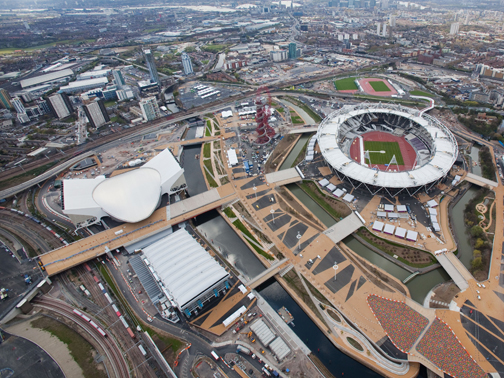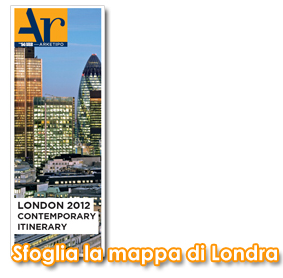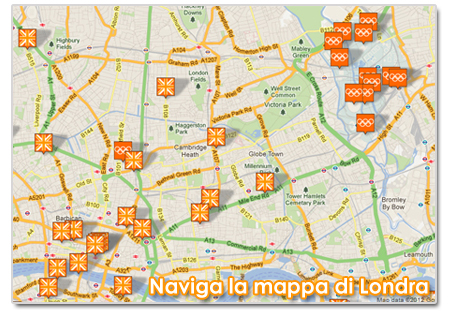Il Regno Unito ha vinto l'assegnazione dei Giochi Olimpici nel
luglio 2005. In quegli anni, il settore edilizio stava vivendo una
sorta di boom e la preoccupazione era che un tale evento avrebbe
comportato un aumento inflazionato dei prezzi. La situazione oggi non
potrebbe essere più diversa. Infatti, i lavori di costruzione delle
strutture e infrastrutture associate con Londra 2012 hanno permesso una
riduzione dell'impatto negativo che la recessione stava avendo, e ancora
ha, sul settore edilizio. La costruzione del Parco Olimpico ha
esteso gli orizzonti del settore sotto una serie di molteplici aspetti.
L'ODA (Olympic Delivery Authority), committente dell'intera operazione e
autorità responsabile per il rilascio della maggior parte dei contratti
di costruzione, ha utilizzato lo schema contrattuale locale definito
New Engineering Contracts per incoraggiare un approccio non conflittuale
e che a tutt'oggi ha sicuramente avuto un impatto positivo sul successo
del programma. Nel Regno Unito esistono diverse forme contrattuali e,
di queste, la maggior parte sono state redatte in passato e perfezionate
nel tempo. Il vantaggio di un simile approccio consiste nel fatto che
le clausole sono state testate in diverse sedi giudiziarie e, di
conseguenza, il settore ha maturato una maggiore dimestichezza con i
dettagli formali delle forme contrattuali e le loro possibili
interpretazioni in tribunale. L'aspetto negativo, invece, è che la
filosofia del contratto nel suo complesso rimane invariata e tende a non
adeguarsi con il progresso dell'industria delle costruzioni. Circa 20
anni fa, l'Institution of Civil Engineers, riconoscendo che le proprie
condizioni di contratto standard avevano generato nel tempo una sorta di
approccio conflittuale nell'adempimento dei contratti, ha stilato una
nuova serie di documenti che rappresentasse un approccio più
collaborativo e meno conflittuale e che facilitasse varie forme di
partnering. L'intenzione era di comporre una forma di contratto semplice
che utilizzasse parole di facile comprensione e interpretazione. La
prima edizione è stata denominata Engineering Construction Contract,
sostituita oggi dal New Engineering Contract (per le opere di
costruzione) e dal NEC Professional Services Contract (per i servizi di
pianificazione, progettazione e altri servizi professionali). Anche la salute e la sicurezza in cantiere
sono state tra i grandi successi dell'ODA. L'obiettivo della
committenza era di mantenere zero incidente, tale aspirazione è stata
quasi raggiunta al momento della scrittura di questo articolo. Si
possono comunque riportare almeno trenta periodi da un milione di ore
lavorate senza incidenti di rilievo, oltre a cinque periodi da due
milioni di ore e due periodi da tre milioni di ore: un risultato
sorprendente per un cantiere di queste dimensioni e durata temporale. In
tema di salute sul posto di lavoro, l'ODA ha installato un ambulatorio
medico in cantiere, dove ogni lavoratore può recarsi per una visita e
ricevere cure mediche. L'adempimento dei target del programma lavori e
del budget non era ovviamente negoziabile, visto che il termine ultimo
era la Cerimonia di apertura del 27 luglio 2012.
L'attenzione continua alla consegna delle varie fasi del programma era
tra gli obiettivi principali non solo del team della committenza, ma
anche di tutti i consulenti, imprese e fornitori. Verso la conclusione
del progetto, l'ODA ha avviato la sua "Learning Legacy" -
un'iniziativa tesa a raccogliere e disseminare le lezioni imparate
durante la pianificazione, progettazione e costruzione del Parco
Olimpico e che è ora disponibile on line. Contemporaneamente una serie
di conferenze tenute negli istituti professionali e negli uffici
commerciali ha aumentato la conoscenza e la consapevolezza di questo
progetto. All'interno del programma, sono stati implementati i temi di
uguaglianza e diversità e tutti i fornitori si sono attivamente
impegnati per dare un'opportunità di lavoro ai giovani disoccupati della
zona. Un simile atteggiamento ha incontrato notevole successo in
cantiere, dove la forza lavoro era in gran parte del posto. Il parco
olimpico di Londra viene giustamente preso come un esempio dei risultati
che si possono ottenere nel settore delle costruzioni. Cinquant'anni di
investimenti nelle infrastrutture sono stati materializzati nei 5 anni
di questo progetto all'avanguardia, con un budget contenuto, un
curriculum esemplare in tema di sicurezza, un approccio collaborativo
grazie a una leadership chiara, a un'amministrazione lineare e a un
senso reale dello scopo e della responsabilità sociale. È ancora troppo
presto per poter discutere in modo conclusivo dell'impatto delle
Olimpiadi di Londra 2012. Tuttavia, i primi segni riscontrati sono
positivi: la realizzazione del Parco Olimpico ha creato posti di lavoro
per la comunità locale, non solo per gli operai edili, ma anche per gli
operatori di sostegno, come i fornitori di cibo e bevande o
abbigliamento. L'apertura di Westfield City all'ingresso del Parco
Olimpico ha avuto per la comunità locale vantaggi analoghi, oltre che a
influire positivamente sulla rigenerazione della zona. Le abitazioni
previste per il villaggio porteranno famiglie, stabilità e benessere e i
nuovi collegamenti (ferrovia internazionale ad alta velocità e servizio
per il centro di Londra offerto dal treno superveloce "Javelin")
incoraggeranno ulteriori investimenti nell'area. Si prevede che
Stratford diventerà una comunità pulsante in maniera simile a quanto
accaduto a Canary Wharf una decina di anni fa. Chiaramente, ci sarà
anche un'eredità sportiva, quando il Parco Olimpico riaprirà con il nome
di Queen Elizabeth Park e ospiterà una piscina olimpionica, i migliori
circuiti ciclabili del Regno Unito e uno stadio iconico, nonché altri
campi sportivi. Sarà un centro di eccellenza sportiva per il Regno
Unito, con tutti i vantaggi socio-economici che questo comporta.
The
UK won the Olympic Games in July 2005. At the time the construction
industry was enjoying something of a boom, and there were concerns at
the time that prices would be high as the industry was busy. How
different is the situation now! In commercial terms, work provided by
the construction of the Park, and the associated work on nearby and
inter-related infrastructure, has provided a soft landing for the
construction industry as the UK went into recession. In many ways the
Olympic Park construction has pushed forward the boundaries of
construction. The Olympic Delivery Authority, responsible for letting
most of the construction contracts, used the New Engineering Contracts
suite of contract conditions, to encourage a non-confrontational
approach, which has certainly been successful. In the UK there are
several standard forms of contract used for construction procurement,
most of them having been written some years ago and refined over time.
The advantage of such an approach is that the clauses are tested in
various dispute resolution hearings, and consequently the industry
become familiar with the meanings and intentions of the contracts, and
how a court of law would interpret them. A disadvantage of this approach
is that the overall philosophy of the contract remains for many years -
it tends not to "move with the times". About 20 years ago, the
Institution of Civil ngineers, having recognised that their standard
Conditions of Contract ad over time created something of a
confrontational approach to contracting, set out to produce a new set of
contract documents that represented a modern desire to have fewer
disputes, a collaborative approach, and partnering. It was intended to
be a simple contract using everyday words in common usage. The first
edition was called the Engineering Construction Contract, superseded now
by the New Engineering Contract (for construction works) and the NEC
Professional Services Contract (for planning, design and other
professional services). Health & safety has also been one of the
ODA's big successes, by setting out to achieve zero accidents and for
much of the time achieving that. Thirty periods of one million hours
without a reportable injury, plus five periods of two million hours and
two periods of three million hours were achieved, which is remarkable
for a busy and diverse site. For occupational health the ODA established
a medical centre on site, where any employee could visit to discuss
ailments and receive treatment. The ODA's attention to health &
safety will set the bar for other major projects to follow. The focus of
delivering on time and on budget was of course non-negotiable given the
27 July 2012 Opening Ceremony deadline, and the constant attention to
delivery and adherence to the programme pervaded not only the client
team but also all the consultants, contractors and suppliers. Towards
the end of the project the ODA initiated their "Learning Legacy" - an
initiative designed to capture and record lessons learned in the
planning, design and construction of the park. These are available on
line, and a series of talks at professional institutions and business
offices has raised awareness of this work. Throughout the project the
themes of equality and diversity have been pursued, and all the
suppliers have been engaged in actively seeking work opportunities for
the unemployed young people in the area. This has met with considerable
success on site, with a good proportion of the workforce living locally.
The London Olympic Park is quite rightly held up as a great example of
what can be achieved in construction. Fifty years of infrastructure
investment in 5 years, ahead of time, below budget, with an exemplary
safety record, a collaborative approach, achieved by clear leadership,
straightforward governance, and a real sense of purpose and social
responsibility. The impact of the Games is too early to tell. The early
signs though are good: the construction of the Olympic Park has provided
significant employment in the community, not only for construction
workers but also for support workers such as food & drink, clothing
suppliers. The opening of Westfield City adjacent to the Park has also
benefitted the community in the same ways, as well as bringing wealth
into the area. Housing planned for the Park will bring families,
stability and wealth, and the new transport links (International
high-speed rail, and the Javelin service to the centre of London) will
also encourage investment in the area. We expect to see Stratford
develop into a vibrant community is a similar way to Canary Wharf a
decade ago. Clearly there will also be a sporting legacy. When the Park
reopens after the Games as the Queen Elizabeth Park, it will house an
Olympic swimming pool, the best cycling facilities in the UK and an
iconic stadium as well as fields of play for various other sports. It
will be a centre of sporting excellence for the UK, with the associated
economic and social benefits that that will bring.









